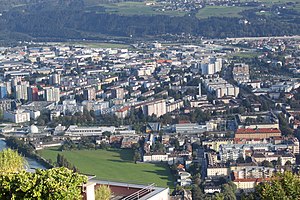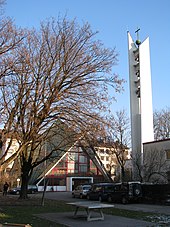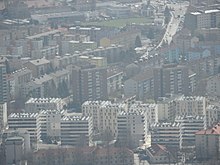Reichenau (Innsbruck)
|
Reichenau Statistical district |
|
|---|---|
| Basic data | |
| Pole. District , state | Innsbruck (I), Tyrol |
| Pole. local community | Innsbruck ( KG Pradl ) |
| Locality | Pradl |
| Coordinates (K) | 47 ° 16 '29 " N , 11 ° 25' 11" E |
| height | 570 m above sea level A. |
| Residents of the stat. An H. | 12,133 (2014) |
| Building status | 480 (2014) |
| surface | 1.01 km² |
| Post Code | 6020 Innsbruck |
| prefix | + 43/0512 (Innsbruck) |
| Statistical identification | |
| Statistical district | 8 Reichenau |
| Counting district / district | Reichenau-West, Reichenau-East (70101 X [25/26]) |
 The Reichenau from the Hungerburg seen from |
|
| Source: STAT : index of places ; BEV : GEONAM ; TIRIS ; City of Innsbruck: Statistics - Numbers ;
(K) Coordinate not official
|
|
The Reichenau is a district in the east of Innsbruck with 12,133 inhabitants (as of April 2014), which was laid out as a residential area after the Second World War.
Location and statistical data
Reichenau is a statistical district of the city of Innsbruck, which belongs to the parliamentary group and cadastral municipality of Pradl . It is bounded in the north by the Sill and Inn , in the east by the Lange Weg, in the southwest and west by Egerdachstraße, Kravoglstraße, Reichenauer Straße and Fennerstraße. Reichenau borders the statistical districts (clockwise from the north) industrial area Mühlau / Arzl , industrial area Roßau , Amras , Pradl and Dreiheiligen-Schlachthof .
The district consists of the two statistical districts ( counting districts ) Reichenau-West (57.7 ha, 6966 inhabitants, 344 buildings) and Reichenau-Ost (43.8 ha, 5167 inhabitants, 136 buildings; as of April 2014), which are passed through Radetzkystraße and General-Eccher-Straße are to be separated. The district has 12,133 inhabitants and a population density of 11,954 inhabitants / km². 15.3% of the population are younger than 15 years, 24.7% older than 65. The proportion of foreigners is 12.6%. The Reichenau thus has the third highest child quota and the second highest senior citizen quota of all Innsbruck districts.
history

The Reichenau was originally a community to Amras belonging floodplain at the mouth of the River Sill in the Inn, the 1288 first overall Urbar Tyrolean Count . Meinhard II as Owe daz Omeras was mentioned. Even before that, clearing and draining of the floodplain was probably started in order to gain pastureland.
The name Reichenau appears for the first time in a document from 1461, when Duke Sigmund der Münzreich ain Wismad and Grund, Raut or Reychnaw named his loyal people in the village of Amras. The name Reichenau indicates that the area has been made arable by slash and burn .
During the reign of Duke Sigmund (1446–1490) the horse jump is said to have taken place in the area of today's Egerdachstraße, which is reported in the Tyrolean rhyme of 1558. A noble boy is said to have jumped over a ditch around 12 meters wide unharmed with his horse. The place of the jump was later marked by two memorial stones made from Höttinger breccia . One of them, with a shield on one side and a simple cross on the other, has been preserved, the second was replaced in the 20th century.
The Reichenauer Gutshof has been traceable since the 15th century ; it was owned by the rulers and served to supply the Innsbruck court. It comprised several buildings and around 50 hectares of agricultural land. After the younger Tyrolean line of the Habsburgs died out , the estate was sold to Count Johann von Spaur. It belonged to the von Spaur family until 1812, after which it changed hands several times. The city of Innsbruck bought it in 1902, and it was used in particular to supply the city with milk.
In 1904 the Pradl fraction and with it Reichenau were separated from the Amras community and incorporated into Innsbruck.
On June 1, 1925, the first Innsbruck airport was opened in Reichenau . It was not only used for recreational aviation, but also scheduled flights with five-seat Fokker and Junkers aircraft to Munich , Vienna and Zurich were carried out by the Österreichische Luftverkehrs-Aktiengesellschaft and the Süddeutsche Lufthansa . The airport was abandoned during World War II and relocated to its current location in the Höttinger Au in 1947 .
From 1941 to 1945, the Reichenau camp was located in the Roßau area , a work education camp originally planned by the Gestapo as a reception camp . Since 1972, a memorial stone has been commemorating the victims of the camp on the former camp site.
After the Second World War, there was a great housing shortage in Innsbruck, mainly due to immigration. The local council therefore decided on October 16, 1952 to close the manor and to build a new residential area on the site, including that of the former airport, which quickly developed into a district with over 10,000 inhabitants. In 1959/60 the Catholic Pauluskirche was built, in 1962/64 the Evangelical Resurrection Church was built in the immediate vicinity . In 1963/65 the Bundesrealgymnasium Reithmannstraße was built, in 1965/68 the double elementary school Reichenau, 1967/71 the secondary school Reichenau. The manor with outbuildings was demolished in 1970.
For the 2012 Winter Youth Olympic Games , the third Olympic Village was built instead of the abandoned Eugen barracks . The 13 passive house buildings with 444 apartments were inhabited by 1,000 athletes during the games.
coat of arms
Blazon : The split shield shows in the white front field on a green shield foot a representation of the Roßsprungsteines with Austrian shield and cross, in the red rear field, however, the golden, lowered sword of St. Apostle Paul and the golden abbot's staff with the black snake of St. Abbot Bishop Pirmin with a black snake snaking up from the ground below.
Since only municipalities are authorized to do so in Tyrol, Reichenau does not have an official coat of arms. As for the other Innsbruck districts, an unofficial district coat of arms was designed, which was adopted by the Reichenau associations in 1990. With the horse jumping stone it reminds of the history of the district and with the sword and abbot's staff of the two church patrons.
Infrastructure and traffic
While there was still a wide range of uses during the creation of the new district, including a. due to trade, barracks or a campsite, Reichenau is now practically a purely residential area. The infrastructure is therefore based on local needs. Reichenau has several kindergartens, an elementary school, a new middle school and a grammar school (BG / BRG Reithmannstrasse). There are two Catholic parish churches (St. Paulus and St. Pirmin ) and the Evangelical Church of the Resurrection on their territory .
The main traffic axis is the Reichenauer Straße, which runs in an arc parallel to the Sill and Inn from west (Pradl) to east ( Grenobler Brücke / Langer Weg) through the district. Important cross streets are Andechsstrasse and Radetzkystrasse. Two large green spaces with playgrounds and leisure facilities run in an east-west direction through the district, along the Sill and Inn and Gutshofweg south of Reichenauer Straße.
Reichenau was originally served by the IVB bus lines R and O, which were operated as trolleybus lines from 1988 to 2007 . Line O was replaced by a tram (lines 2 and 5) in 2019 . In addition, the bus lines C, F and T also touch the district.
The first independent associations were founded soon after the new district was built. So the Reichenau today u. a. via a volunteer fire brigade, a rifle company , a music band and, as the most important sports club, the SVG Reichenau , whose football section plays in the Regionalliga West .
literature
- Franz-Heinz Hye : The history of Reichenau. In: Pfarramt St. Paulus (Ed.): 25 years of the state memorial church and parish of St. Paulus. Innsbruck 1985, pp. 20-25
- Josefine Justić: From the Reichenauer Gutshof to the Reichenau district. In: Innsbruck informs, April 2001, p. 22 ( digitized version )
- Josefine Justić: The Reichenau labor camp 1941–1945. In: Innsbrucker Stadtnachrichten, No. 1, 1986, p. 16 ( digitized version )
- Herbert Woditschka: The airport in Reichenau. In: Innsbrucker Stadtnachrichten, No. 3, 1978, p. 12 ( digitized version )
Web links
- Reichenau , in the history database ofthe association "fontes historiae - sources of history"
Individual evidence
- ↑ a b City of Innsbruck: Statistical classification of the districts of Innsbruck (PDF; 1.2 MB)
- ↑ City of Innsbruck: area, inhabitants and number of buildings of the individual census districts and statistical districts of the city of Innsbruck (as of April 2014) (PDF; 143 kB)
- ↑ City of Innsbruck: Statistical Districts of Innsbruck (PDF; 1.3 MB)
- ↑ City of Innsbruck: District mirror 2014 (PDF; 410 kB)
- ^ NHT hands over 3rd Olympic Village in Innsbruck , Innsbruck informs, October 17, 2011
- ^ Franz-Heinz Hye: District coat of arms for the Reichenau. In: Innsbrucker Stadtnachrichten, August 1990, p. 28 ( digitized version )
- ↑ Steffen Arora: Innsbruck puts two new tram lines into operation. The standard from January 17, 2019






